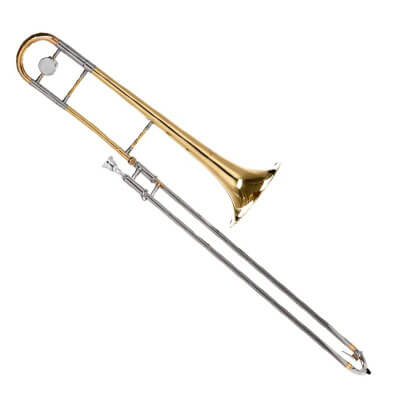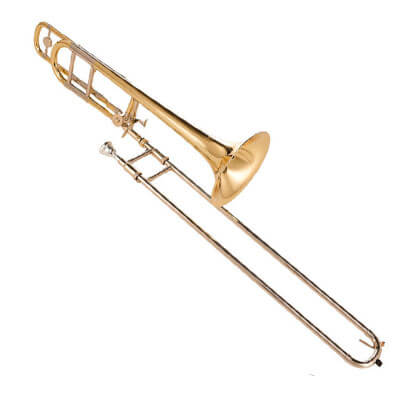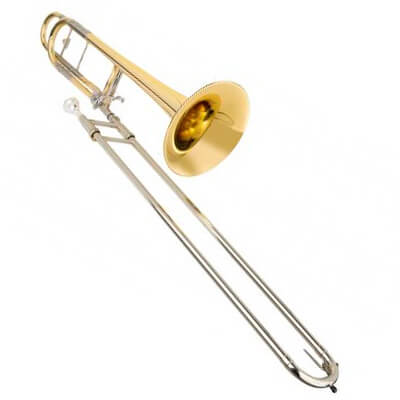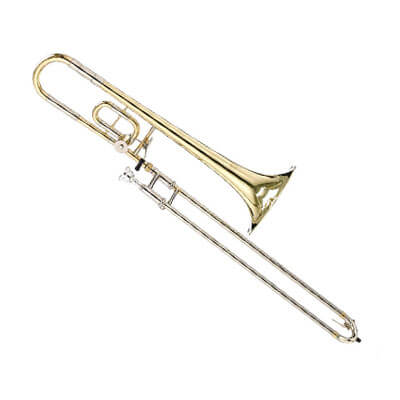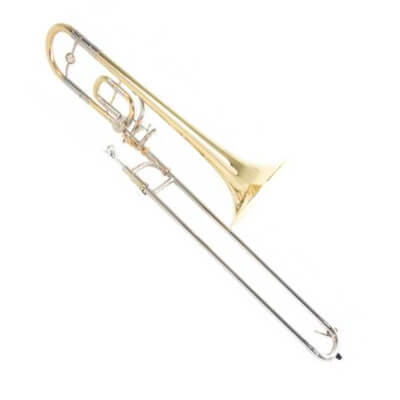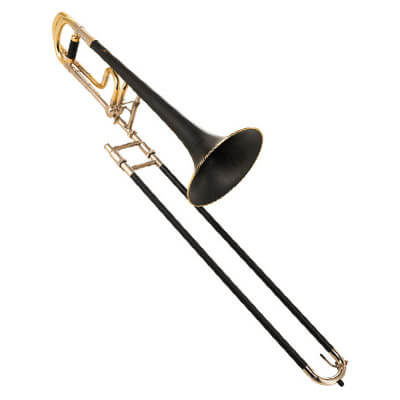Buying a trombone: My 7 best recommendations 2025
I have summarised my recommendations for good trombones here. You’ll find the best trombones and all the information you need for beginners, advanced players and kids. The answers to the frequently asked questions will help you before you buy.
This text has been translated into English. Please report spelling mistakes to sebastian@musiksocke.com
What kind of trombone are you looking for?
Frequently asked questions:
Trombone for beginners
If you are a beginner and don’t want to invest too much, you can get a fully-fledged instrument for between 150 and 500 euros. Apart from the favourable price, good intonation, easy response and a smooth slide are decisive for the start.
Particularly recommendable in this price range is the Thomann Classic TB525 L Trombone. The instrument has a high-quality finish and basically offers everything a trombone should have. The purchase price includes a mouthpiece, slide grease and a case. Compared to trombones that cost four-figure sums, the trombone is not as nicely balanced. For beginners, however, this is not a hurdle at the beginning and after a few years you can change to an advanced instrument.
The Classic Cantabile TP-42 tenor trombone is also suitable for beginners due to its good price-performance ratio. It has a good response and is easy to play. The set includes a matching mouthpiece, cleaning cloth and case. After the first practice sessions, it is advisable to change to a higher quality mouthpiece. However, the set is sufficient for a start and you can begin playing immediately.
Trombone for advanced players
Every musician who strives for progress wants a higher quality instrument over time. If you are looking for a trombone that meets higher demands in terms of sound quality and workmanship, you have to look in the price range between 800 and 3,000 euros.
The Bach TB-450B tenor trombone is equipped with an additional quart valve. This is purely an additional feature that is not absolutely necessary. However, it extends the range and saves the player from having to extend the slide tube for many low notes. The TB-450B offers a high-quality sound over the entire range and is appreciated by advanced players because of the precise control of the notes.
The Kühnl & Hoyer .547 Bb/F is a high-quality tenor trombone for advanced players. This is noticeable in the workmanship and the wide and variable sound spectrum. The intonation is excellent and with a little practice experienced musicians can produce a round sound.
Trombone for kids
The ideal age for children to learn to play the trombone is around 10 to 12 years. By then, their shoulders and arms are sufficiently developed for them to be able to hold and grip the instrument well. Some manufacturers now offer trombones for kids that are shorter than the conventional instruments.
Occasionally, the alto trombone, which is somewhat smaller than the tenor trombone, is recommended for this purpose. However, it should be borne in mind that more compact instruments require more effort to blow. This is a small drawback that can cause kids to quickly lose interest in playing.
The Thomann TF-300 Junior Trombone is a good trombone that is suitable for kids. It is very light and offers solid workmanship. Its smaller design makes it easy for children to play. The instrument is only 1 metre long in total and can therefore take 6 slide positions.
The Roy Benson TT-220 Bb-/C trombone is a trombone specially designed for kids. Thanks to the length-adjustable push rod and the individually adjustable hand rest, kids can adjust the trombone to their size. The instrument is otherwise on the level of other Roy Benson models and has a smooth action, good intonation and produces a beautiful full sound.
Trombone for crazy people
Professionals in the field of brass instruments will be so crazy and also interested in extraordinary trombones. Special are not only models that have a unique sound, but combine that with a high level of innovation.
If you are looking for something special, the daCarbo Bb/F-Tenor Trombone is a must. It has a carbon bell. The outer slide is also made of carbon and therefore much more robust and straight than a conventional brass slide. The gap between the outer and inner slides is reduced to a minimum.
How do I recognize a good trombone?
On high-quality instruments the body and slide are made of brass, the inner slide tube is usually made of nickel silver.
To balance the weight, good quality trombones have a counterweight at the upper end. This is usually attached between or at the upper bend of the tube. When buying a trombone, you should make sure that this weight is made of metal, just like the instrument itself. Weights sheathed in plastic are usually not as durable.
In general, a musical instrument should have as few plastic parts as possible – in the case of the trombone, preferably none at all. An exception to this is the small foot, which is attached to its lower end to protect the slide and may have a rubber coating. In any case, this “shock absorber” is one of the minimum requirements for a quality trombone.
The size of the bell does not necessarily say anything about the quality of the trombone, as is often assumed. Smaller, narrower bells produce a higher sound and sharper tones, while larger ones can be used to play softer tones. On good instruments, all parts are gently tapered and have no sharp edges. The better the trombone, the finer and more detailed the workmanship of its parts.
When buying a trombone, make sure that the condensation valve on the underside of the slide is easy to grip and closes tightly. There is also a closing mechanism on the top of the draw tube. It should have a slight resistance when pulling the draw back to the home position, which is ensured by a built-in spring. Otherwise, the slide tubes would hit each other during playing and cause an unpleasant shock to the wind player’s lips.
What accessories do I need?
Mouthpiece – Every trombone comes with a mouthpiece. However, especially with the cheapest instruments, savings are made in this area. Therefore, a new mouthpiece can improve the sound of even an average instrument. I recommend the Denis Wick 5880 6BS as a good start into the world of mouthpieces. For me, it’s a good all-rounder that’s okay in price and has an entirely different quality than the cheap mouthpieces. It is available with a small and a large shank.
Mute – A mute is not always included in the purchase price and must therefore be purchased separately. The choice between common cup, straight and plunger mutes seems endless. In addition, there are many other variations for the trombone. Therefore, I recommend a multi-function mute for beginners. The Denis Wick DW5529 for the tenor break can be used as a cup, straight and plunger mute and has an easy response as well as a beautiful sound, especially in the middle and high pitches. It is also offered for the bass trombone.
Stands – A special stand for the trombone is important for longer breaks or gentle storage. It is practical if it is a foldable stand that can be easily transported to the rehearsal or concert. Of course, stability is crucial. The instrument must not fall over, even if someone bumps into it. I can recommend the K&M 14985 trombone stand because it is foldable and light. So it’s easy to transport. Despite its low weight, it has a stable stand. The adjustable height makes the stand suitable for any trombone.
Case or bag – A trombone is best kept in its original hard case. Especially with instruments in the lower price segment, one should not expect too resistant transport boxes. If you have to transport your trombone a lot, you should get a sturdy case. Padded transport bags (gig bags) are practical, but they cannot compete with a hard shell case in terms of stability. The Thomann Fibertech Trombone Carbon is light and yet extremely stable (thanks to fibreglass). Nothing can happen to your trombone during transport.
Wiper and cleaning brush – Since condensation accumulates inside the trombone while playing, it should be cleaned after each use if possible. There are specially shaped brushes that clean the trombone without leaving any residue. It is important that all parts of the brush are soft and rounded. Special cleaning brushes are also available for the mouthpiece. Good brushes can be found in the Ultra-Pure Trombone Care Kit. With the brushes included, you can get around every curve in the slides.
Slide grease – Indispensable for every trombonist is the so-called slide grease or slide oil. It is applied to the inner slide tube. This allows the two tubes to slide against each other and at the same time prevents direct contact between the metal parts. The traction grease is available in solid or liquid form for spraying on. Many musicians use the Yamaha Slidecream.
Lacquer care – To clean the brass lacquer and make it shine again, you should treat it to lacquer care from time to time. The cleaning milk is applied with a soft cloth and then polished. At the same time, the varnish care coats the instrument with a fine impregnating layer. La Tromba lacquer polish is recommended.
Music stands – Foldable metal models are an absolute all-rounder because they can be used almost anywhere. Especially for musicians who travel a lot (for music lessons, or later in a band or orchestra), these music stands are indispensable. In their own rooms, stand models made of wood, metal or a combination of both are very decorative. They are also more stable. When buying a music stand, it is important to note that it should be height-adjustable and have stable feet. I have the Thomann Orchestra Stand Deluxe for practising at home and I am satisfied. It has a solid stand and is infinitely adjustable to any height.
What are the best trombone brands?
I compiled this list together with experienced musicians. The quality and longevity of the instruments in recent years were important in the assessment of the brands.
How much does a good trombone cost?
A good trombone costs between 800 and 3,000 euros. For beginners, there are already simple models in the range of 150 to 500 euros. The difference lies above all in the material used and the sophistication of the mechanics. If you practise frequently on the trombone, you will quickly notice the difference in quality compared to high-quality trombones.
You can find my recommendation for a good trombone here.
What is the best trombone for beginners?
The Thomann Classic TB525 L Trombone for approx. 330 euros is suitable as a trombone for beginners. It is surprisingly well-made for this price range and produces a beautiful sound. Some experienced musicians use the TB525 as a second trombone.
For advanced trombonists, I recommend the Bach TB-450B Bb/F-Tenor Trombone for about 1,700 Euros. The instrument lets professionals play the notes cleanly and thus produces a precise and balanced sound.
Here are more details on the trombone for beginners.
⚠️
* For the links marked with a star, we receive a commission on a purchase. The price does not change for you. Please use our link and support the independent work of Musiksocke. Thank you very much!
✔️
The product recommendations made here are based on my experience and conversations with expert musicians. All products presented here meet the criteria of the checklist.
🏦
All prices are incl. VAT plus shipping costs. The amount was estimated by me and may differ from the actual price. As an Amazon partner, I earn on qualified sales. This also applies to Thomann, Kirstein and all other partners.
String instruments:
Wind instruments:
Key instruments:
Drums:
Recording:


